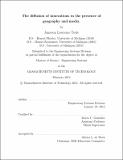The diffusion of innovations in the presence of geography and media
Author(s)
Toole, Jameson Lawrence
DownloadFull printable version (1.302Mb)
Other Contributors
Massachusetts Institute of Technology. Engineering Systems Division.
Advisor
Marta C. González.
Terms of use
Metadata
Show full item recordAbstract
Increasingly, the world we live in is digital, mobile, and online. As a consequence, many of your seemingly mundane actions are recorded, archived, and for the first time widely accessible to both the generators and curators of this information. From this fire hose of digital breadcrumbs, we can learn an enormous amount about ourselves as individuals and societies. Simple questions such as where we go, who we are meeting, and how we interact when we get there can be explored with incredibly high resolution and richness. Through new emiprical and analytic tools, we can leverage information generated from rapidly expanding online social networks, revealing the beautiful and often surprising complexity of everyday human behavior. We are able to harness data from millions of cell phone users to better understand how people move through cities, use roads, and interact with their neighbors. This thesis deals with quantifying, analyzing, and ultimately modeling sociotechnical systems. More specifically, it focuses on modeling the diffusion of innovations in time and space. While there has been much work examining the affects of social network structure on innovation adoption, models to date have lacked important features such as meta-populations reflecting real geography or influence from mass media forces. This thesis shows that these are features crucial to producing more accurate predictions of a social contagion and technology adoption at the city level. Using data from the adoption of the popular micro-blogging platform, Twitter, a model of adoption on a network is presented. The model places friendships in real geographic space and exposes individuals to mass media influence. Results show that homophily both amongst individuals with similar propensities to adopt a technology and geographic location is critical to reproduce features of real spatiotemporal adoption. Furthermore, estimates suggest that mass media was responsible for increasing Twitter's user base two to four fold. To reflect this strength, traditional contagion models are extended to include an endogenous mass media agent that responds to those adopting an innovation as well as influencing agents to adopt themselves. The final chapter of this thesis addresses the future. The ubiquity of digital devices like mobile phones and tablets is opening rich new avenues of research. The massive amounts of data generated and stored by these devices can be used to gain a better understanding of the complex socio-technical systems they sense. The same tools, techniques, and analogies utilized in the first three chapters of this thesis can now literally be taken to the streets. With mobile phones that record when and where activities take place, a new window has been opened on urban systems. Future work will explore how people use cities dynamically to improve transportations systems and inform urban planners. New measurements will help understand what cities do well, when they fail, and why. At the core of this new domain, is an interdisciplinary approach to complex socio-technical systems that combines many fields and methods. This view forms a more holistic view of problems and potential solutions. The thesis presented stands as an example of data, theory, and simulation for diverse areas can be combined to gain novel insights into human behavior.
Description
Thesis (S.M.)--Massachusetts Institute of Technology, Engineering Systems Division, 2012. Cataloged from PDF version of thesis. Includes bibliographical references (p. 101-105).
Date issued
2012Department
Massachusetts Institute of Technology. Engineering Systems DivisionPublisher
Massachusetts Institute of Technology
Keywords
Engineering Systems Division.